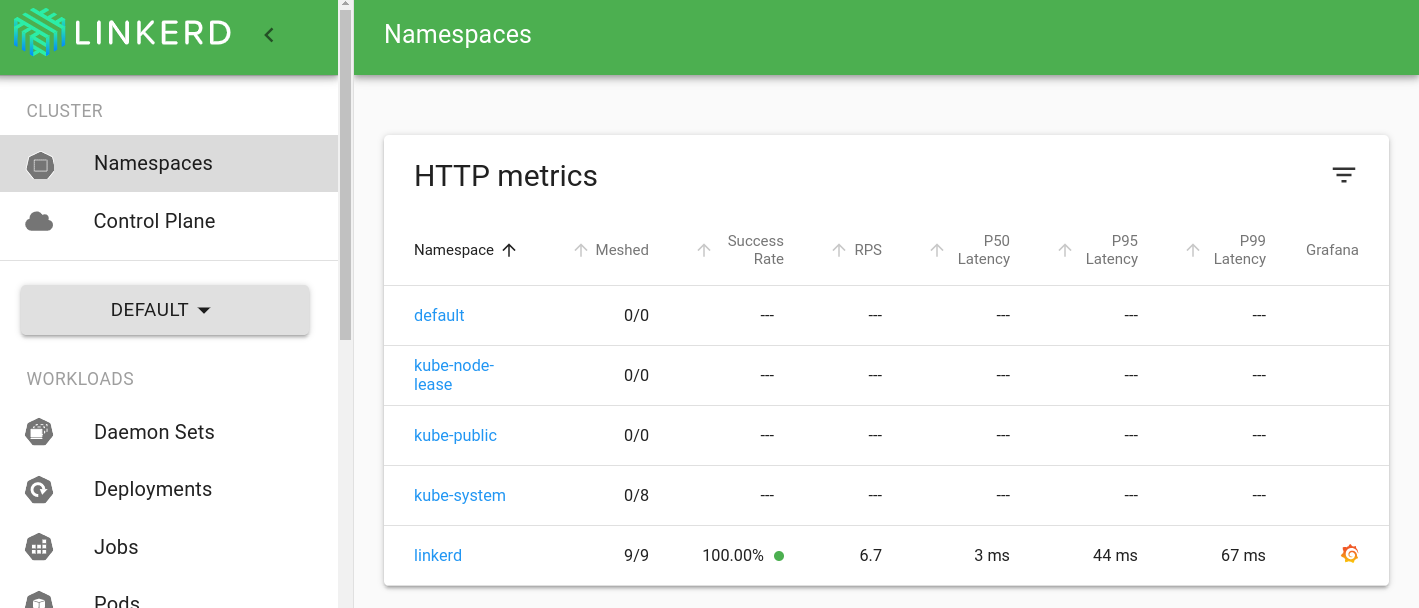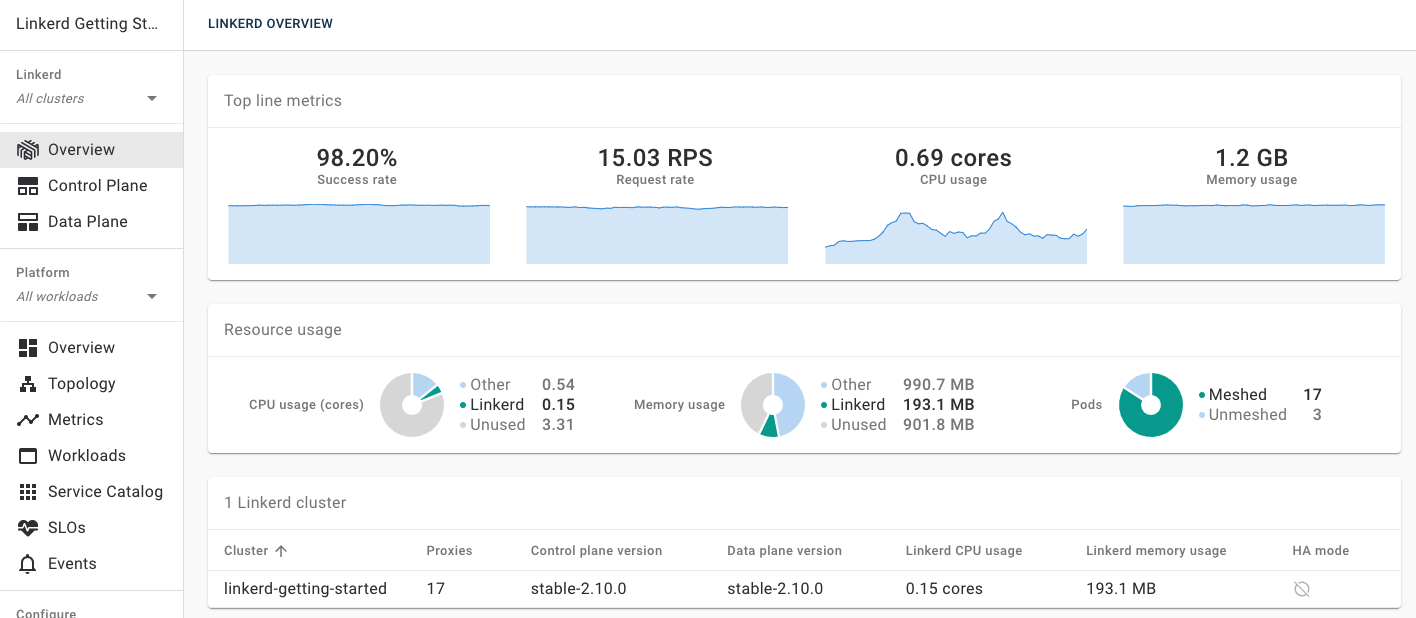Getting Started
Welcome to Linkerd! 🎈
In this guide, we’ll walk you through how to install Linkerd into your Kubernetes cluster. Then we’ll deploy a sample application to show off what Linkerd can do.
Installing Linkerd is easy. First, you will install the CLI (command-line interface) onto your local machine. Using this CLI, you’ll then install the control plane onto your Kubernetes cluster. Finally, you’ll “mesh” one or more of your own services by adding Linkerd’s data plane to them.
Note
Step 0: Setup
Before we can do anything, we need to ensure you have access to modern
Kubernetes cluster and a functioning kubectl command on your local machine.
(If you don’t already have a Kubernetes cluster, one easy option is to run one
on your local machine. There are many ways to do this, including
kind, k3d,
Docker for Desktop,
and more.)
You can validate your setup by running:
kubectl version --short
You should see output with both a Client Version and Server Version
component.
Now that we have our cluster, we’ll install the Linkerd CLI and use it validate that your cluster is capable of hosting the Linkerd control plane.
(Note: if you’re using a GKE “private cluster”, there are some extra steps required before you can proceed to the next step.)
Step 1: Install the CLI
If this is your first time running Linkerd, you will need to download the
linkerd command-line interface (CLI) onto your local machine. The CLI will
allow you to interact with your Linkerd deployment.
To install the CLI manually, run:
# Setting LINKERD2_VERSION sets the version to install.
# If unset, you'll get the latest available edge version.
export LINKERD2_VERSION=stable-2.10.2
curl --proto '=https' --tlsv1.2 -sSfL https://run.linkerd.io/install | sh
Be sure to follow the instructions to add it to your path.
Alternatively, if you use Homebrew, you can install the CLI
with brew install linkerd. You can also download the CLI directly via the
Linkerd releases page.
Once installed, verify the CLI is running correctly with:
linkerd version
You should see the CLI version, and also Server version: unavailable. This is
because you haven’t installed the control plane on your cluster. Don’t
worry—we’ll fix that soon enough.
Step 2: Validate your Kubernetes cluster
Kubernetes clusters can be configured in many different ways. Before we can install the Linkerd control plane, we need to check and validate that everything is configured correctly. To check that your cluster is ready to install Linkerd, run:
linkerd check --pre
If there are any checks that do not pass, make sure to follow the provided links and fix those issues before proceeding.
Step 3: Install the control plane onto your cluster
Now that you have the CLI running locally and a cluster that is ready to go, it’s time to install the control plane.
The first step is to install the control plane core. To do this, run:
linkerd install | kubectl apply -f -
The linkerd install command generates a Kubernetes manifest with all the core
control plane resources. (Feel free to inspect the output.) Piping this manifest
into kubectl apply then instructs Kubernetes to add those resources to your
cluster.
Note
Now let’s wait for the control plane to finish installing. Depending on the speed of your cluster’s Internet connection, this may take a minute or two. Wait for the control plane to be ready (and verify your installation) by running:
linkerd check
Next, we’ll install some extensions. Extensions add non-critical but often useful functionality to Linkerd. For this guide, we will need:
- The viz extension, which will install an on-cluster metric stack; or
- The buoyant-cloud extension, which will connect to a hosted metrics stack.
For this guide, you can install either or both. To install the viz extension, run:
linkerd viz install | kubectl apply -f - # install the on-cluster metrics stack
To install the buoyant-cloud extension, run:
curl --proto '=https' --tlsv1.2 -sSfL https://buoyant.cloud/install | sh # get the installer
linkerd buoyant install | kubectl apply -f - # connect to the hosted metrics stack
Once you’ve installed your extensions, let’s validate everything one last time:
linkerd check
Assuming everything is green, we’re ready for the next step!
Step 4: Explore Linkerd!
With the control plane and extensions installed and running, we’re now ready to explore Linkerd! If you installed the viz extension, run:
linkerd viz dashboard &
You should see a screen like this:

If you installed the buoyant-cloud extension, run:
linkerd buoyant dashboard &
You should see a screen lke this:

Click around, explore, and have fun! One thing you’ll see is that, even if you don’t have any applications running on this cluster, you still have traffic! This is because Linkerd’s control plane components all have the proxy injected (i.e. the control plane runs on the data plane), so traffic between control plane compnments is also part of the mesh.
Step 5: Install the demo app
To get a feel for how Linkerd would work for one of your services, you can install a demo application. The emojivoto application is a standalone Kubernetes application that uses a mix of gRPC and HTTP calls to allow the users to vote on their favorite emojis.
Install emojivoto into the emojivoto namespace by running:
curl --proto '=https' --tlsv1.2 -sSfL https://run.linkerd.io/emojivoto.yml | kubectl apply -f -
Before we mesh it, let’s take a look at the app. If you’re using
Docker Desktop at this point
you can visit http://localhost directly. If you’re not using
Docker Desktop, we’ll need to forward the web-svc service. To forward
web-svc locally to port 8080, you can run:
kubectl -n emojivoto port-forward svc/web-svc 8080:80
Now visit http://localhost:8080. Voila! The emojivoto app in all its glory.
Clicking around, you might notice that some parts of emojivoto are broken! For example, if you click on a doughnut emoji, you’ll get a 404 page. Don’t worry, these errors are intentional. (And we can use Linkerd to identify the problem. Check out the debugging guide if you’re interested in how to figure out exactly what is wrong.)
Next, let’s add Linkerd to emojivoto by running:
kubectl get -n emojivoto deploy -o yaml \
| linkerd inject - \
| kubectl apply -f -
This command retrieves all of the deployments running in the emojivoto
namespace, runs the manifest through linkerd inject, and then reapplies it to
the cluster. The linkerd inject command adds annotations to the pod spec
instructing Linkerd to “inject” the proxy as a container to the pod spec.
As with install, inject is a pure text operation, meaning that you can
inspect the input and output before you use it. Once piped into kubectl apply,
Kubernetes will execute a rolling deploy and update each pod with the data
plane’s proxies, all without any downtime.
Congratulations! You’ve now added Linkerd to existing services! Just as with the control plane, it is possible to verify that everything worked the way it should with the data plane. To do this check, run:
linkerd -n emojivoto check --proxy
That’s it! 👏
Congratulations, you’re now a Linkerd user! Here are some suggested next steps:
- Use Linkerd to debug the errors in emojivoto
- Add your own service to Linkerd without downtime
- Set up automatic control plane mTLS credential rotation or set a reminder to do it manually before they expire
- Learn more about Linkerd’s architecture
- Hop into the #linkerd2 channel on the Linkerd Slack
Welcome to the Linkerd community!


